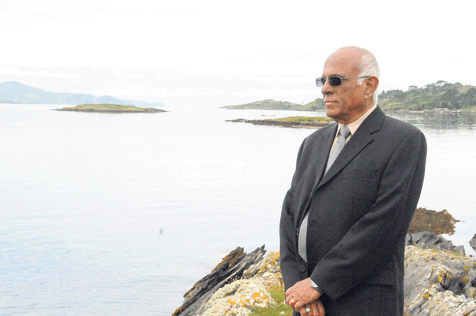Exactly 30 years after the Air India disaster, Brian Moore talks to a heartbroken father who makes the annual trip to the tiny village that remembers his two sons, who lost their lives that day
THE radio on the bridge of the LE Aisling crackled to life with an urgent message.
An aircraft had disappeared off the radar screens at the transatlantic control centre in Shannon. All communications had been lost.
The aircraft was approximately 50 miles from where the naval ship the LE Aisling and her crew were on patrol. Lt Commander James Robinson immediately set course for the last recorded position of the missing aircraft and readied his crew for the rescue mission.
‘My thoughts at the time were to try to effect a rescue, I had no idea of the size of the plane involved but assumed that it might be a relatively small aircraft,’ retired Captain James Robinson told The Southern Star.
The evening before, June 22nd 1985, Air India flight 182 from Montreal, Canada was preparing to depart for London and then on to Delhi, India. One passenger was missing, and the other 329 men, women and children were waiting in the departure lounge. Two of those waiting were brothers Sanjay (14) and Deepak (11) Turlapati.
‘There was great excitement, the boys were on their way to spend the summer with their grandparents in India. Their suitcases were packed with the many trophies and awards they had received, so that they could show their relatives all they had achieved in school in Canada,’ the boys’ father Mr Babu Turlapati said.
As the passengers waited to board the Boeing 747, there was a problem in the baggage handling area. The x-ray machine scanning the suitcases broke down. The baggage handlers were given hand-held scanners that could detect minute quantities of explosives and told to hurry up and get the cargo hold of Air India flight 182 loaded.
Only one suitcase triggered an alarm. The baggage handler turned to a security officer who passed the suitcase for loading.
The bag was not searched and the missing passenger did not turn up, as the aircraft pushed away from the departure gate.
‘Looking back now, 30 years later, I can still see Sanjay walking towards the departure lounge with the rest of the unaccompanied children. He turned back several times and waved. He looked sad and I remember my wife asking “Why is he looking back so much?”’ Mr Turlapati recalled, earlier this week.
As Air India flight 182 approached the West Cork coast, travelling at over 500mph, at an altitude of approximately 30,000ft, a bomb in a suitcase exploded.
The aircraft disappeared from the radar screen in Shannon at 8.12am on the morning of June 23rd 1985. All 329 people, including 86 children, were killed.
When the LE Aisling and her crew arrived at the scene, the sea was littered with wreckage.
‘It took us about three hours to reach the scene,’ recalled Captain Robinson. ‘En route we learned that the aircraft was an Air India passenger aircraft with over 300 people on board.
‘We still hoped that we were going to recover survivors, but when we arrived we were very quickly surrounded by wreckage and many bodies. It was very obvious that there would be no survivors. We set about recovering bodies.’
Captain Robinson added that the vast majority of his crew were in their 20s, with possibly a few in their late teens. Their response was immense.
‘Nothing was too big a task. For example, the three men in the Gemini rib, petty officer Muiris Mahon, leading seaman John McGrath (both naval divers) and able seaman Terry Browne, refused to be relieved. They recovered bodies for about 11 hours until it became dark. I felt very proud and humbled to be in command of such a group of 40 ordinary Irishmen who could do such extraordinary things, because it was their duty,’ Captain Robinson said.
Over a number of days, naval units from three counties, a number of fishing and merchant vessels, as well as a number of RNLI lifeboat crews, recovered 131 bodies from the sea and brought them to Cork.
Also making their way to Cork were the relatives of those who were on the Air India flight.
‘When we arrived, we were all touched by the kindness, love and support from the people of Cork who were waiting to meet us. Everything was organised so well, and we were brought to the hospital so we could try to identify the bodies that had been recovered,’ Mr Turlapati recalled.
Of the 131 bodies recovered, all were identified by their loved ones, but many relatives left Ireland without finding their family members.
‘We found Sanjay. He looked like he was asleep. There wasn’t a mark on him. But Deepak is still out there,’ Mr Turlapati said.
The relatives were brought to Ahakista, a little village on the Sheep’s Head peninsula. And overlooking Dunmanus Bay, they prayed for their loved ones and for all those still missing.
‘When we first arrived in Ahakista all those years ago, I remember, even with all the sorrow and sadness, I felt a certain amount of peace when we gathered by the water’s edge,’ Mr Turlapati continued.
And the families have gathered at the waters edge, where Dunmanus Bay opens out into the Atlantic Ocean, every year since 1985, at the Air India Memorial.
‘We come back every year and we meet old friends who have looked after the memorial and ensure that we still receive all the support and love that we remember from all those years ago.
‘The people of this area are so wonderful and have done so much for us that each year it is like we are coming home. Ahakista has given us a peace that keeps us going. Without the memorial or the people here I do not know how we could have coped,’ he said.








